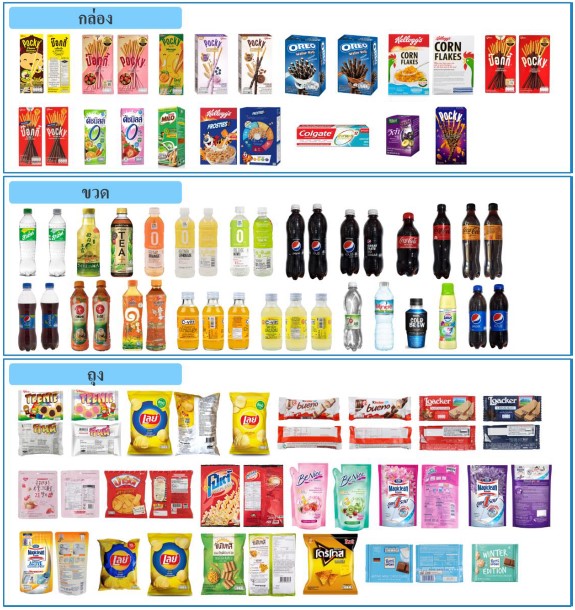Self-checkout system using vision-based object detection and subcategory recognition
Keywords:
Self-checkout system, Deep learning, Sub category, Feature pointAbstract
The purpose of this research was to study and develop a conceptual framework for self-checkout systems to use only cameras at the checkout station to detect goods from customers. This framework is designed to use deep learning models and computer vision to classify similar products or identify sub-category products with similar appearances but different sizes. The framework is flexible to use with no retraining whenever a new product or package is introduced by using feature point extraction and feature point matching. The researcher uses the YOLO model to detect and identify the shape of the products and also defines the bounding boxes in the detected image, and then defines the feature point of the product using feature point algorithms (e.g. SIFT, ORB, and BRISK) and feature matching with reference images. The results from the experiment on the Thai products dataset that was collected by the researcher found that this framework can be applied to effectively detect and recognize retail products in a self-checkout system. The YOLO model can predict the shape and position of the product with an average mAP of 0.727, and the best feature point algorithm for product classification from this experiment is SIFT, which has an accuracy of 82.96%. In summary, SIFT can improve the accuracy of YOLO. Because of SIFT, the system can accurately predict the product class, although the YOLO bounding box does not cover an entire region occupied by a product. However, this experiment has a limitation because SIFT has low accuracy when predicting products in bottle shape. This is expected to be a result of the light and shadows reflected from the bottles. Therefore, the environment at the checkout area should be controlled. The product images should be clear, have no obstructions, and be free from disturbing light and shadows.
References
Chaiyasoonthorn, W., & Suksa-ngiam, W. (2011). Factors influencing store patronage: A study of modern retailers in Bangkok Thailand. International Journal of Trade, Economics and Finance, 2(6), 520. (in Thai)
Hsia, C. H., Chang, T. H. W., Chiang, C. Y., & Chan, H. T. (2022). Mask R-CNN with new data augmentation features for smart detection of retail products. Applied Sciences, 12(6), 2902.
James, N., Antony, N. T., Shaji, S. P., Baby, S., & Annakutty, J. (2021). Automated Checkout for Stores: A Computer Vision Approach. Revista GEINTEC-Gestao Inovacao e Tecnologias, 11(3), 1830-1841.
Leutenegger, S., Chli, M., & Siegwart, R. Y. (2011, November). BRISK: Binary robust invariant scalable keypoints. In 2011 International conference on computer vision. pp. 2548-2555.
Liu, H., Li, Y., & Liu, D. (2021, July). Object detection and recognition system based on computer vision analysis. In Journal of Physics: Conference Series(Vol. 1976, No. 1, p. 012024). IOP Publishing.
Lowe, D. G. (1999). Object recognition from local scale-invariant features. In Proceedings of the seventh IEEE international conference on computer vision. pp. 1150-1157.
Padilla, R., Netto, S. L., & Da Silva, E. A. (2020). A survey on performance metrics for object-detection algorithms. In 2020 international conference on systems, signals and image processing (IWSSIP). pp. 237-242.
Redmon, J., Divvala, S., Girshick, R., & Farhadi, A. (2016). You only look once: Unified, real-time object detection. In Proceedings of the IEEE conference on computer vision and pattern recognition. pp. 779-788.
Rublee, E., Rabaud, V., Konolige, K., & Bradski, G. (2011, November). ORB: An efficient alternative to SIFT or SURF. In 2011 International conference on computer vision. pp. 2564-2571.
Shoman, M., Aboah, A., Morehead, A., Duan, Y., Daud, A., & Adu-Gyamfi, Y. (2022). A Region-Based Deep Learning Approach to Automated Retail Checkout. arXiv preprint arXiv:2204.08584.
Wei, X. S., Cui, Q., Yang, L., Wang, P., & Liu, L. (2019). RPC: A large-scale retail product checkout dataset. arXiv preprint arXiv:1901.07249.
Wei, Y., Tran, S., Xu, S., Kang, B., & Springer, M. (2020). Deep learning for retail product recognition: Challenges and techniques. Computational intelligence and neuroscience, 2020(1), 8875910.

Downloads
Published
Issue
Section
Categories
License
Copyright (c) 2024 Journal of Applied Science and Emerging Technology

This work is licensed under a Creative Commons Attribution-NonCommercial-NoDerivatives 4.0 International License.

